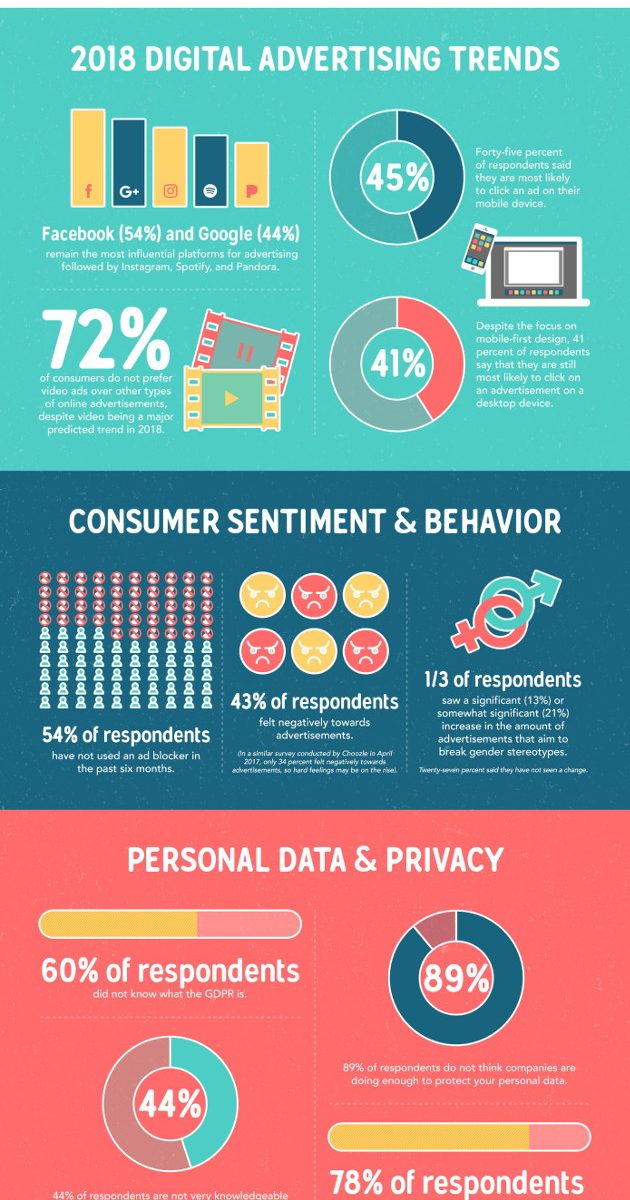Digital Marketing Tips For The Holiday Season – Last year, November and December sales exceeded $690 billion, according to the National Retail Federation, and roughly 20% of those sales were made online. Continue reading “Digital Marketing Tips For The Holiday Season”
5 Bad SEO Content Tactics You Should Have Abandoned Already
Bad SEO content is comparable to a bunch of cockroaches invading a house.
Continue reading “5 Bad SEO Content Tactics You Should Have Abandoned Already”
4 SEO Trends Communicators Should Track
SEO Trends – Ranking first on a Google search engine results page (SERP) is considered an honorable achievement—but it’s not the only goal that matters. Continue reading “4 SEO Trends Communicators Should Track”
2018 Digital Advertising Trends
2018 Digital Advertising Trends
- 7 in 10 consumers do not prefer video ads over other types of online advertisements, despite predictions that video would be a major trend in 2018.
- Nearly half (43%) of respondents felt negatively toward online advertisements—up 9% from a similar survey conducted in April 2017.
- Over three-quarters (78%) of respondents think the US government should adopt stricter privacy and security standards.

Read the full article on MarketingProfs
SEO and Social Media Strategy Questions You Should Be Asking
Q: When looking at our marketing spend, what’s more important for digital growth: SEO or social media?
Before consulting, I made my living as an editor in media. Each job I held taught me the same lesson: Digital growth is not about manipulating tools like search engine optimization (SEO) and social media. It’s about using them to reach customers. Then it’s your job to create a sustainable relationship off of those platforms.
Continue reading “SEO and Social Media Strategy Questions You Should Be Asking”
2018 Software Development Trends That Will Continue Into 2019
That new technology you’re hopping on may be all the rage now, but will anyone remember it this time next year? Trends in technology can fade quickly as advancements are rolled out at lightning speed.
Continue reading “2018 Software Development Trends That Will Continue Into 2019”
Chrome’s long-promised HTTP ‘not secure’ website warnings arrive
Three and a half years ago, Google predicted the day would come when Chrome would warn us all of the security risks of using the web’s seminal HTTP technology to deliver web pages to your browser.
Continue reading “Chrome’s long-promised HTTP ‘not secure’ website warnings arrive”
Best Ways To Improve Your SEO And Why You Need To Do It
If done right, and in combination with other marketing and technical strategies, SEO can help your business get good rankings and land on the front page of Google search. Continue reading “Best Ways To Improve Your SEO And Why You Need To Do It”
THANK YOU for making Hartman Technology your Local Best!
For the 2nd year in a row you have made Hartman Technology your Local Best in Software Development & Web Design! We thank you for making that happen! Continue reading “THANK YOU for making Hartman Technology your Local Best!”
Adobe Patches Zero-Day Flash Flaw
Adobe has released an emergency update to address a critical security hole in its Flash Player browser plugin that is being actively exploited to deploy malicious software. If you’ve got Flash installed — and if you’re using Google Chrome or a recent version of Microsoft Windows you do — it’s time once again to make sure your copy of Flash is either patched, hobbled or removed.
In an advisory published today, Adobe said it is aware of a report that an exploit for the previously unknown Flash flaw — CVE-2018-5002 — exists in the wild, and “is being used in limited, targeted attacks against Windows users. These attacks leverage Microsoft Office documents with embedded malicious Flash Player content distributed via email.”
The vulnerable versions of Flash include v. 29.0.0.171and earlier. The version of Flash released today brings the program to v. 30.0.0.113 for Windows, Mac, Linux and Chrome OS. Check out this link to detect the presence of Flash in your browser and the version number installed.
Both Internet Explorer/Edge on Windows 10 and Chrome should automatically prompt users to update Flash when newer versions are available. At the moment, however, I can’t see any signs yet that either Microsoft or Google has pushed out new updates to address the Flash flaw. I’ll update this post if that changes.
Adobe credits Chinese security firm Qihoo 360 with reporting the zero-day Flash flaw. Qihoo said in a blog post that the exploit was seen being used to target individuals and companies in Doha, Qatar, and is believed to be related to a nation-state backed cyber-espionage campaign that uses booby-trapped Office documents to deploy malware.
In February 2018, Adobe patched another zero-day Flash flaw that was tied to cyber espionage attacks launched by North Korean hackers.
Hopefully, most readers here have taken my longstanding advice to disable or at least hobble Flash, a buggy and insecure component that nonetheless ships by default with Google Chrome and Internet Explorer. More on that approach (as well as slightly less radical solutions) can be found in A Month Without Adobe Flash Player. The short version is that you can probably get by without Flash installed and not miss it at all.
For readers still unwilling to cut the Flash cord, there are half-measures that work almost as well. Fortunately, disabling Flash in Chrome is simple enough. Paste “chrome://settings/content” into a Chrome browser bar and then select “Flash” from the list of items. By default it should be set to “Ask first” before running Flash, although users also can disable Flash entirely here or whitelist/blacklist specific sites.
By default, Mozilla Firefox on Windows computers with Flash installed runs Flash in a “protected mode,” which prompts the user to decide if they want to enable the plugin before Flash content runs on a Web site.
Another, perhaps less elegant, alternative to wholesale kicking Flash to the curb is to keeping it installed in a browser that you don’t normally use, and then only using that browser on sites that require Flash.
Administrators have the ability to change Flash Player’s behavior when running on Internet Explorer on Windows 7 and below by prompting the user before playing Flash content. A guide on how to do that is here (PDF). Administrators may also consider implementing Protected View for Office. Protected View opens a file marked as potentially unsafe in Read-only mode.
Read the full article at Krebson Security










